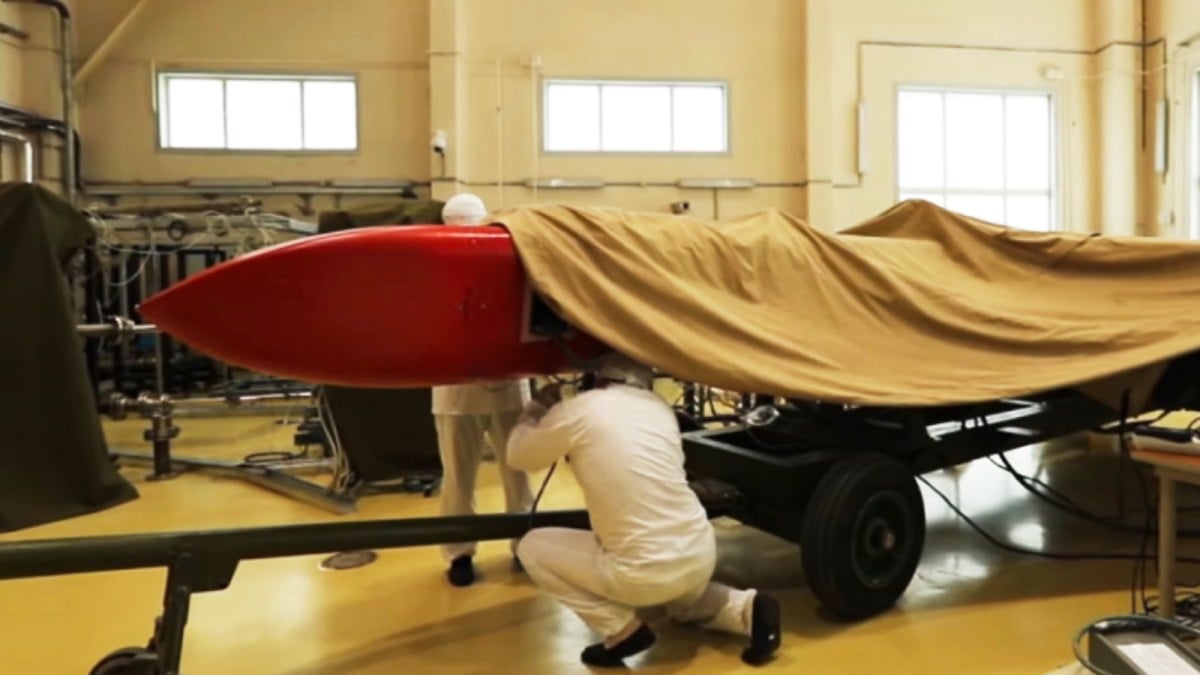US researchers have reportedly identified a possible deployment site for Russia’s 9M730 Burevestnik (NATO Name: SSC-X-9 Skyfall), a nuclear-powered cruise missile that Russian President Vladimir Putin has described as “invincible.”
Utilizing satellite imagery, the researchers believe the site is located near a nuclear warhead storage facility in Russia, potentially signaling the missile’s imminent deployment.
According to a Reuters report, satellite images captured on July 26 by Planet Labs provided crucial insight into the site’s location and construction.
The site is adjacent to a nuclear storage facility called Vologda-20, also known as Chebsara, which is located about 475 kilometers (295 miles) north of Moscow.
Decker Eveleth, an analyst with the Center for Naval Analyses (CNA), a US-based research organization, made the discovery. Eveleth analyzed the satellite images and observed nine horizontal launch pads being built, arranged in three distinct groups.
These launch pads are positioned within large protective berms, likely designed to defend the facility against potential attacks or mitigate the risks of chain explosions in case of an accidental detonation.
The proximity to Vologda-20, combined with the nearly completed state of the site, suggests that the Burevestnik missile could soon be integrated into the Russian Strategic Rocket Forces, a branch of Russia’s military responsible for the country’s nuclear arsenal.
Eveleth noted that the arrangement of the launch pads and supporting infrastructure indicates the development of a “large, fixed missile system.”
He explained that the Burevestnik, known by its NATO designation as SSC-X-9 Skyfall, is currently Russia’s only large, fixed missile system being developed. This has led researchers to speculate that the newly discovered site is intended for its deployment.
Radio Free Europe journalist Mark Krutov provided additional evidence of the site’s construction, sharing images of the facility allegedly taken in 2022 and 2023.
https://twitter.com/kromark/status/1830723248583004575
Krutov highlighted the dangers associated with the Burevestnik missile, recalling an incident in 2019 at a separate test site in Nyonoksa where a Burevestnik-related accident reportedly occurred, leading to a deadly explosion.
Carl Bildt, co-chair of the European Council on Foreign Relations and former Prime Minister and Foreign Minister of Sweden, responded to the Reuters report via X (formerly Twitter), stating, “Could this be the location for Russia’s nuclear-powered 9M370 Burevestnik missile? It’s been under development for decades, has a dubious test record, and serves an unclear strategic objective. But it for sure consumes resources.”
The Burevestnik: A Revolutionary Missile With Major Flaws?
The Burevestnik missile is part of a suite of advanced weapons that Putin unveiled in 2018. It boasts a near-unlimited range and the ability to evade US missile defenses.
Its reported range of 15,000 miles surpasses even that of the Sarmat intercontinental ballistic missile (ICBM), one of Russia’s most powerful nuclear weapons.
However, Hans Kristensen of the Federation of American Scientists, who reviewed the satellite imagery, added that while the features of the site are consistent with those of a missile deployment facility, he could not definitively confirm its purpose.
He pointed out that it is unusual for Moscow to position missile launch sites so close to nuclear warhead storage, leaving some questions about the exact nature of the facility.
The Burevestnik’s development history has been somewhat troubled. According to the Nuclear Threat Initiative (NTI), only two out of thirteen tests have shown partial success since 2016.

However, these findings are dated, and the missile’s current status suggests that developers may have made progress in testing the weapon.
The missile’s nuclear-powered engine introduces additional complexities. Experts have voiced concerns that its operation could lead to radiation contamination along its flight path.
Yet, the new report said that there are indications that Russian engineers might have developed solutions to mitigate this risk.
The Burevestnik has garnered significant attention and criticism, particularly from US officials who have denounced it as a “radiation-spewing, nuclear-powered cruise missile,” likening it to a “flying Chernobyl.”
The Burevestnik missile is powered by an unshielded nuclear reactor, which serves as its propulsion system. This unique design theoretically grants it the capability to travel vast, virtually unlimited distances without the need for refueling.
If successfully deployed, the Burevestnik would represent a key advancement in missile technology, making it the first operational missile of its kind to use this form of propulsion.
In an analysis for Foreign Policy, Decker Eveleth, associate research analyst at CNA, discussed the practical challenges associated with the missile’s purported unlimited range.
Although the Russian Ministry of Defense claims the missile can travel indefinitely, operating such a missile over long distances or for extended periods comes with significant drawbacks, said Eveleth.
Cruise missiles typically use satellite communication for navigation, but satellite signals are susceptible to jamming or spoofing. To counter this, the Burevestnik is equipped with an inertial navigation system that relies on mechanical accelerometers and gyroscopes to calculate its position based on speed, direction, and flight duration.
However, according to Eveleth, small errors in this system can accumulate over time, potentially causing the missile to deviate from its intended course.
Despite the complexities surrounding its development, Burevestnik’s extended range offers several significant advantages. Unlike conventional missiles powered by jet engines, which must balance fuel efficiency with radar detectability, the Burevestnik’s nuclear propulsion eliminates such trade-offs.
With a virtually limitless power supply, it can remain airborne for extended periods, making it a highly unpredictable weapon capable of evading traditional detection methods.
Eveleth pointed out that while the US Tomahawk missile has a range of 770 to 1,550 miles and cannot reach intercontinental targets, the Burevestnik’s reactor could theoretically enable it to fly for days, reaching targets anywhere in the United States while flying at low altitudes to evade radar.
Nonetheless, accurately guiding the missile to its target remains a significant challenge.
- Contact the author at ashishmichel(at)gmail.com
- Follow EurAsian Times on Google News




